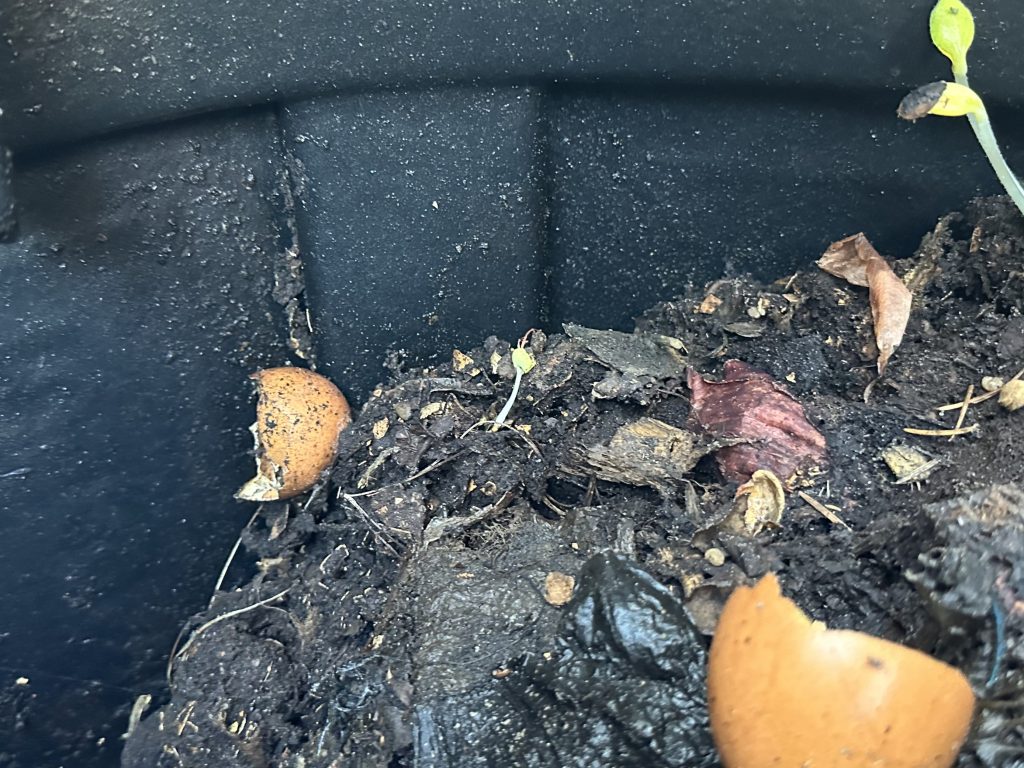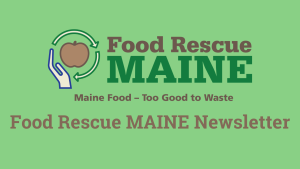
Just pitch your apple core into the woods…or maybe not
I admit it…I’m guilty of this. There have been times when I didn’t get a chance to finish my apple before embarking on a walk. Or, I hiked a trail and munched on that delicious fruit on the summit. The end result was always the same. After I ate the last bite of crisp sweetness, I faced the unpleasant prospect of carrying that sticky core all the way back to my house, or car, or wherever. To be honest, I just as often threw it into the woods. I figured it would biodegrade or be eaten. Either way, it would be gone. Out of sight, out of mind. At least, that was my attitude until a casual conversation forced me to reevaluate how I had been treating the natural world.
It was late May, my senior year of high school. My classmates and I had one final project before we were free forever. One day, while we were working, I fell into a conversation with a friend (who also happened to be a Maine Guide). We were talking about the National Parks – places that attract huge numbers of nature-seekers. Our conversation centered around the question: does the number of park visitors need to be limited? On one hand, everyone deserves an equal opportunity to experience the outdoors. On the other hand, every visit erodes away at these places. My friend proposed a solution: more education about Leave No Trace Principles. At the time, I had never heard of these. But now, I can tell you that these are rules to minimize harmful human impacts on the outdoors. The rule that is relevant here is #3: Dispose of Waste Properly. Simply put, whatever you bring in, bring out. Yes, this includes food. Here’s why.
It makes a mess
We’re taught that food biodegrades. After all, composting is supposed to be great. Isn’t this the same thing? Not really. Compost is specifically designed to break down food quickly. Let me explain. Compost is not a pile of food scraps that becomes a pile of dirt. It is a recipe, a careful mixing of carbon-rich materials (“browns”), nitrogen-rich materials (“greens”), water, and air. And just like a recipe, you have to combine your ingredients in the right order, at the right time, and apply just the right amount of heat. Imagine instead of making your famous chocolate cake by mixing the flour and the eggs together, you just drop 2 eggs on the floor and a pound of flour on your counter. What is the problem there? Well, you didn’t make a cake, you made a mess. The measurements aren’t right, the ingredients aren’t in the same place, and it hasn’t been heated up to a temperature where it could actually bake. If you throw an apple core in the woods, you aren’t combining the appropriate amounts of browns, greens, air, or water. Your ingredients aren’t in the same place and the temperature isn’t hot enough for the materials to break down quickly. So– a mess.

The summit of Gorham Mountain, Acadia National Park. What would happen if every one of the annual 4 million visitors to Acadia National Park left an apple core behind?
It’s bad for wildlife
But that apple core will break down…slowly. In the interim that hungry raccoon or deer might, in fact, get to it. Why is this a problem? A few reasons. First, some human food can make animals sick (like the M&Ms in the trail mix you dropped). Even if they won’t become sick, you’re still introducing foods that those species normally wouldn’t eat. Additionally, undigested seeds could introduce nonnative plant species to the area. Unfortunately, by dropping food you’re teaching them that your favorite walk, or hike, is a great place to get a meal. This tends to increase human-wildlife interactions and wildlife aggression. Perhaps none of this sounds like a big deal. So what if a raccoon gets an apple core? Or if my apple core is decomposing under a bush for a couple months? True– one person is unlikely to impact the entire ecosystem. And I thought this way, too. But in my conversation about Leave No Trace principles, my friend made an excellent point. I’m not the only one who takes these walks or hikes these trails. What happens if everybody does it? 4 million people visit Acadia every year (The U.S. National Park Service, 2022). What if 4 million people chuck an apple into the bushes? I’d be dodging raccoons, squirrels, apple cores, and who knows what else. So no. We aren’t doing the environment a favor. In fact, we’re harming wildlife by throwing food just off the trail.
After that conversation, I became more aware of the need to clean up after myself. I figured the next time I hiked a trail, I could bring that apple core back down with me, all the way from the summit. I knew there was usually a trash can in the parking lot. I could put the apple core there, right? Wrong. Things that go in the trash don’t disappear. They just go somewhere else. In the case of food, they go somewhere worse.

The presence of food in places with both animals and humans tends to increase their interactions, which can impact both groups negatively.
The secret danger of landfills
This environmental issue blindsided me when I became a Food Rescue MAINE intern. Food waste outside isn’t great. But, eventually, it will break down without too much incident (hopefully). But in a landfill? Landfills are deprived of oxygen (a key ingredient in compost!). This does not mean food won’t break down. Oh no, Nature finds a way. Food will just break down with an unfortunate byproduct – methane. In the atmosphere, methane is over 28 times more effective at trapping heat than carbon dioxide. Food waste is responsible for over half of landfill methane emissions (EPA, 2023) and landfills are the third largest source of human-related methane emissions in the United States (EPA, 2024). Yikes.
The magic of compost
So now what? I can’t put that apple core in the woods because it’s bad for the animals. I can’t put it in the trash because it’s bad for the climate crisis. Is there anywhere for food scraps to go? Yes. But first a little background on soil (Sorry, I have to – I took an entire class on this…). Soil is not a homogenous, brown mixture. It is full of organisms, water, air, and nutrients. Plants uptake nutrients from the soil to grow and they take those nutrients with them when they are harvested. Soil can’t just replenish its nutrients. So there’s the answer – my apple core should go in the compost. It will help return nutrients to the soil. But it gets better. Remember when I said that a key ingredient in compost is carbon-containing materials? Well, putting carbon back into the soil keeps it out of the atmosphere. A win-win.

A compost bin is a great way to return nutrients to the soil.
I’m lucky to have a compost bin at home. However, I recognize that not all of us have the time or space to compost. If you do, great! Here’s a link to the EPA’s recommendations. If you don’t, no worries. That’s where a curbside composting service could come in. Instead of putting your food scraps into your trash can, you could leave them in a separate bucket on the curb. Depending on the service, you may get a bucket of fresh compost for your trouble, or peace of mind that your food scraps are being put to good use. Either way, your food scraps aren’t attracting wildlife and they’re not producing methane gas. So what should we all do with those apple cores? Take them home and compost them.
And always remember… Maine food is too good to waste.
–Kathryn B., Mitchell Center Student Intern
I’m a tea-drinking knitter and reader who loves nothing more than a book and a crackling fire on a snowy winter day. In the summer you can find me hiking or swimming.
Citations
- Begum, T. (2021, April 16). Soil degradation: The problems and how to fix them. Natural History Museum, London. https://www.nhm.ac.uk/discover/soil-degradation.html
- Hannah Ritchie (2019) – “Food production is responsible for one-quarter of the world’s greenhouse gas emissions” Published online at OurWorldInData.org. Retrieved from: ‘https://ourworldindata.org/food-ghg-emissions’
- Hannah Ritchie, Pablo Rosado and Max Roser (2022) – “Environmental Impacts of Food Production” Published online at OurWorldInData.org. Retrieved from: ‘https://ourworldindata.org/environmental-impacts-of-food’
- U.S. National Park Service. (2022, March 30). Park Fact Sheet – Acadia National Park (U.S. National Park Service). National Park Service. https://www.nps.gov/acad/learn/facts.htm#:~:text=Acadia%20National%20Park%20receives%20more
- UNDRR. (n.d.). Soil Degradation. United Nations Office for Disaster Risk Reduction. https://www.undrr.org/understanding-disaster-risk/terminology/hips/en0005
- US EPA. (2013, April 17). Composting At Home. United States Environmental Protection Agency. https://www.epa.gov/recycle/composting-home#:~:text=Always%20ensure%20your%20food%20scraps
- US EPA. (2015, August 12). Composting. United States Environmental Protection Agency. https://www.epa.gov/sustainable-management-food/composting
- US EPA. (2019, April 9). Basic Information about Landfill Gas . United States Environmental Protection Agency. https://www.epa.gov/lmop/basic-information-about-landfill-gas

